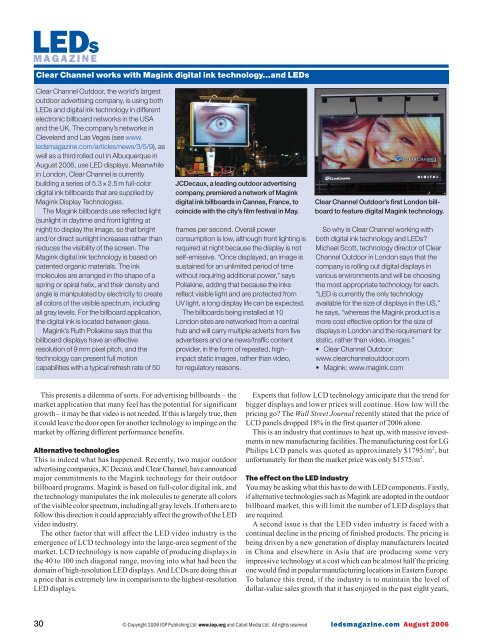LEDs Magazine Review - Beriled
LEDs Magazine Review - Beriled
LEDs Magazine Review - Beriled
- No tags were found...
You also want an ePaper? Increase the reach of your titles
YUMPU automatically turns print PDFs into web optimized ePapers that Google loves.
LEDSMAGAZINEClear Channel works with Magink digital ink technology...and <strong>LEDs</strong>Clear Channel Outdoor, the world’s largestoutdoor advertising company, is using both<strong>LEDs</strong> and digital ink technology in differentelectronic billboard networks in the USAand the UK. The company’s networks inCleveland and Las Vegas (see www.ledsmagazine.com/articles/news/3/5/9), aswell as a third rolled out in Albuquerque inAugust 2006, use LED displays. Meanwhilein London, Clear Channel is currentlybuilding a series of 5.3 × 2.5 m full-colordigital ink billboards that are supplied byMagink Display Technologies.The Magink billboards use reflected light(sunlight in daytime and front lighting atnight) to display the image, so that brightand/or direct sunlight increases rather thanreduces the visibility of the screen. TheMagink digital ink technology is based onpatented organic materials. The inkmolecules are arranged in the shape of aspring or spiral helix, and their density andangle is manipulated by electricity to createall colors of the visible spectrum, includingall gray levels. For the billboard application,the digital ink is located between glass.Magink’s Ruth Poliakine says that thebillboard displays have an effectiveresolution of 9 mm pixel pitch, and thetechnology can present full motioncapabilities with a typical refresh rate of 50JCDecaux, a leading outdoor advertisingcompany, premiered a network of Maginkdigital ink billboards in Cannes, France, tocoincide with the city’s film festival in May.frames per second. Overall powerconsumption is low, although front lighting isrequired at night because the display is notself-emissive. “Once displayed, an image issustained for an unlimited period of timewithout requiring additional power,” saysPoliakine, adding that because the inksreflect visible light and are protected fromUV light, a long display life can be expected.The billboards being installed at 10London sites are networked from a centralhub and will carry multiple adverts from fiveadvertisers and one news/traffic contentprovider, in the form of repeated, highimpactstatic images, rather than video,for regulatory reasons.Clear Channel Outdoor’s first London billboardto feature digital Magink technology.So why is Clear Channel working withboth digital ink technology and <strong>LEDs</strong>?Michael Scott, technology director of ClearChannel Outdoor in London says that thecompany is rolling out digital displays invarious environments and will be choosingthe most appropriate technology for each.“LED is currently the only technologyavailable for the size of displays in the US,”he says, “whereas the Magink product is amore cost effective option for the size ofdisplays in London and the requirement forstatic, rather than video, images.”• Clear Channel Outdoor:www.clearchanneloutdoor.com• Magink: www.magink.comThis presents a dilemma of sorts. For advertising billboards – themarket application that many feel has the potential for significantgrowth – it may be that video is not needed. If this is largely true, thenit could leave the door open for another technology to impinge on themarket by offering different performance benefits.Alternative technologiesThis is indeed what has happened. Recently, two major outdooradvertising companies, JC Decaux and Clear Channel, have announcedmajor commitments to the Magink technology for their outdoorbillboard programs. Magink is based on full-color digital ink, andthe technology manipulates the ink molecules to generate all colorsof the visible color spectrum, including all gray levels. If others are tofollow this direction it could appreciably affect the growth of the LEDvideo industry.The other factor that will affect the LED video industry is theemergence of LCD technology into the large-area segment of themarket. LCD technology is now capable of producing displays inthe 40 to 100 inch diagonal range, moving into what had been thedomain of high-resolution LED displays. And LCDs are doing this ata price that is extremely low in comparison to the highest-resolutionLED displays.Experts that follow LCD technology anticipate that the trend forbigger displays and lower prices will continue. How low will thepricing go? The Wall Street Journal recently stated that the price ofLCD panels dropped 18% in the first quarter of 2006 alone.This is an industry that continues to heat up, with massive investmentsin new manufacturing facilities. The manufacturing cost for LGPhilips LCD panels was quoted as approximately $1795/m 2 , butunfortunately for them the market price was only $1575/m 2 .The effect on the LED industryYou may be asking what this has to do with LED components. Firstly,if alternative technologies such as Magink are adopted in the outdoorbillboard market, this will limit the number of LED displays thatare required.A second issue is that the LED video industry is faced with acontinual decline in the pricing of finished products. The pricing isbeing driven by a new generation of display manufacturers locatedin China and elsewhere in Asia that are producing some veryimpressive technology at a cost which can be almost half the pricingone would find in popular manufacturing locations in Eastern Europe.To balance this trend, if the industry is to maintain the level ofdollar-value sales growth that it has enjoyed in the past eight years,30© Copyright 2006 IOP Publishing Ltd www.iop.org and Cabot Media Ltd. All rights reservedledsmagazine.com August 2006
















